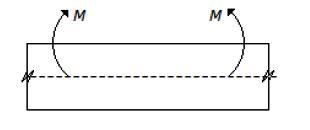Practice Test: Question Set - 11
1. If the rivets in adjacent rows are staggered and the outermost row has only one rivets, the arrangement of the rivets is called
- (A) Chain riveting
- (B) Zigzag riveting
- (C) Diamond riveting
- (D) Crisscross riveting
2. The point of contraflexure is a point where
- (A) Shear
force changes sign
- (B) Bending
moment changes sign
- (C) Shear
force is maximum
- (D) Bending
moment is maximum
3. The value of shear stress which is induced in the shaft due to the applied couple varies
- (A) From maximum at the center to zero at the circumference
- (B) From zero at the center to maximum at the circumference
- (C) From maximum at the center to minimum at the circumference
- (D) From minimum at the center to maximum at the circumference
4. The extremities of any diameter on Mohr's circle represent
- (A) Principal
stresses
- (B) Normal
stresses on planes at 45°
- (C) Shear
stresses on planes at 45°
- (D) Normal and
shear stresses on a plane
5. The materials having same elastic properties in all directions are called
- (A) Ideal materials
- (B) Uniform materials
- (C) Isotropic materials
- (D) Piratical materials
6. The ratio of the largest load in a test to the original cross-sectional area of the test piece is called
- (A) Elastic
limit
- (B) Yield stress
- (C) Ultimate
stress
- (D) Breaking
stress
7. A column is said to be a short column, when
- (A) Its
length is very small
- (B) Its
cross-sectional area is small
- (C) The ratio of
its length to the least radius of gyration is less than 80
- (D) The ratio of
its length to the least radius of gyration is more than 80
8. The total elongation produced in a bar of uniform section hanging vertically downwards due to its own weight is equal to that produced by a weight
- (A) Of same magnitude as that of bar and
applied at the lower end
- (B) Half the weight of bar applied at lower end
- (C) Half of the square of weight of bar applied
at lower end
- (D) One fourth of weight of bar applied at
lower end
9. The lower layer of the beam as shown in the below figure, will be
- (A) In tension
- (B) In
compression
- (C) Neither
in tension nor in compression
- (D) None
of these
10. The tensile strength of the welded joint for double fillet is (where s = Leg or size of the weld, l = Length of weld, and σt = Allowable tensile stress for weld metal)
- (A) 0.5 s.l.σt
- (B) s.l.σt
- (C) √2 s.l.σt
- (D) 2.s.l.σt
11. If a material expands freely due to heating it will develop
- (A) Thermal stresses
- (B) Tensile stress
- (C) Bending
- (D) No stress
12. When a body is subjected to biaxial stress i.e. direct stresses (σx) and (σy) in two mutually perpendicular planes accompanied by a simple shear stress (τxy), then maximum normal stress is
- (A) (σx + σy)/2 + (1/2) × √[(σx - σy)² + 4 τ²xy]
- (B) (σx + σy)/2 - (1/2) ×
√[(σx - σy)² +
4 τ²xy]
- (C) (σx - σy)/2 +
(1/2) × √[(σx + σy)² + 4 τ²xy]
- (D) (σx - σy)/2 -
(1/2) × √[(σx + σy)² + 4 τ²xy]
13. The stress at which extension of the material takes place more quickly as compared to the increase in load is called
- (A) Elastic point of the material
- (B) Plastic point of the material
- (C) Breaking point of the material
- (D) Yielding point of the material
14. A cantilever beam is one which is
- (A) Fixed
at both ends
- (B) Fixed at one
end and free at the other end
- (C) Supported at
its ends
- (D) Supported on
more than two supports
15. In a prismatic member made of two materials so joined that they deform equally under axial stress, the unit stresses in two materials are
- (A) Equal
- (B) Proportional to their
respective moduli of elasticity
- (C) Inversely
proportional to their moduli of elasticity
- (D) Average of the sum of moduli of elasticity
Next Tests:

